Key points of this blog include:
- Digital Transformation sweeps aside traditional industry borders to create new sources of customer and operational value
- Unfortunately, Digital Transformation and “smart” initiatives are struggling, and organizations will need a more pragmatic approach to successful execution per Forrester research
- Organizations must define their “smart” initiatives from perspective of stakeholder journey maps that identify, validate, value and prioritize the use cases that support “smart”
- “Smart” spaces are comprised of interlocking subsystems that decompose into a series of use cases that are identified, validated and valued from the journey maps of your key stakeholders and constituents
- The Digital Transformation Journey Workbook identifies “smart” spaces and digital transformation requirements from perspectives of key stakeholders – the sources of economic value.
Digital Transformation sweeps aside traditional industry borders to create new sources of customer and operational value
Many organizations doom their “smart” spaces initiatives, and the supporting digital transformation, by ignoring the more holistic needs of the key stakeholders and constituents who start and extend their journeys beyond the self-inflicted four walls of your organization. Forrest proclaims in “Predictions 2019: Transformation Goes Pragmatic”, that 2019 represents a year when “smart” and Digital Transformation initiatives will translate into more pragmatic efforts with the aim of “putting points on the board[1]” (see Figure 1).
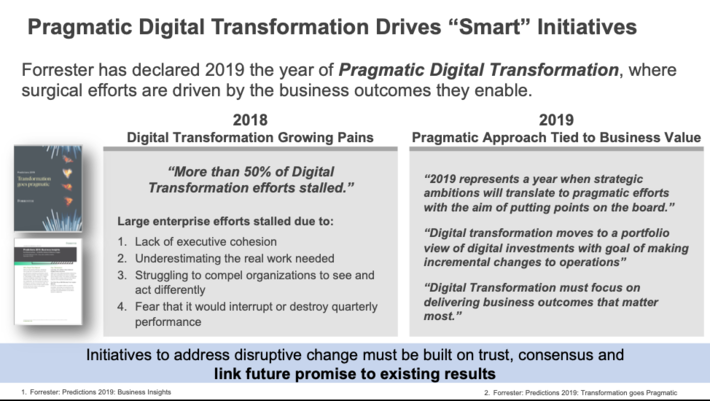
Figure 1: Digital Transformation Success will be guided with Pragmatic Approaches
Organizations are being challenged to create smart spaces – hospitals, trains, malls, universities, factories, hospitals, cities – but lack a pragmatic approach that 1) builds organizational and customer consensus around what to expect from “smart”, while 2) providing a pragmatic framework around which to identify, validate, value and prioritize the use cases (and the interaction between those use cases) that comprise “smart.”
“Smart” spaces are comprised of interlocking subsystems that decompose into a series of use cases that are identified, validated and valued from the journey maps of your key stakeholders and constituents
For example, a “smart” city initiative would include energy, water, transit, safety, security, recycling, events management, maintenance and operations subsystems which would decompose into use cases identified, validated, valued and prioritized from Resident, Employee and Commercial Business journey maps (see Figure 2).
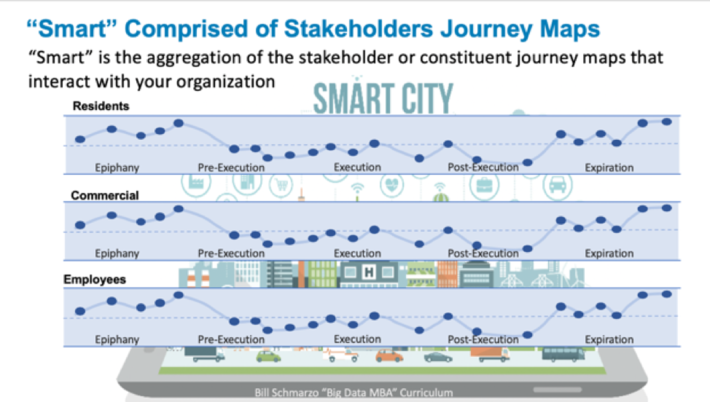
Figure 2: “Smart” is an Aggregation of Key Stakeholders’ Journey Maps
The Digital Transformation Journey Workbook will guide an organization’s “smart” initiative by 1) identifying the sources of customer and market value creation and 2) codifying the organization’s engines of customer and market value capture. The Digital Transformation Journey Workbook will help organizations start, execute and guide their continuously-learning “smart” initiatives, and the associated digital transformation, down the path to success by “putting points on the board” early and often.
Introduction to Digital Transformation
In several previous blogs, I introduced the Digital Transformation Journey (see Figure 3) as a process for:
- Identifying Sources of Value Creation. This is a customer-centric approached (think “outside-in”) to identify, validate, value and prioritize the sources of customer (and market) value creation by leveraging a Design Thinking technique called the “Customer Journey Mapping.”
- Identifying Processes/Engines of Value Capture. This is a production-centric approach (think “inside-out”) leveraging Michael Porter’s Value Chain Analysis methodology to identify the internal organizational capabilities necessary to capture the sources of value creation.
- Identifying Digital Assets. This is the Digital Solution Architecture that fuels the creation, sharing and reuse of the organization’s digital assets (decisions, metrics, KPI’s, analytics, data and apps).
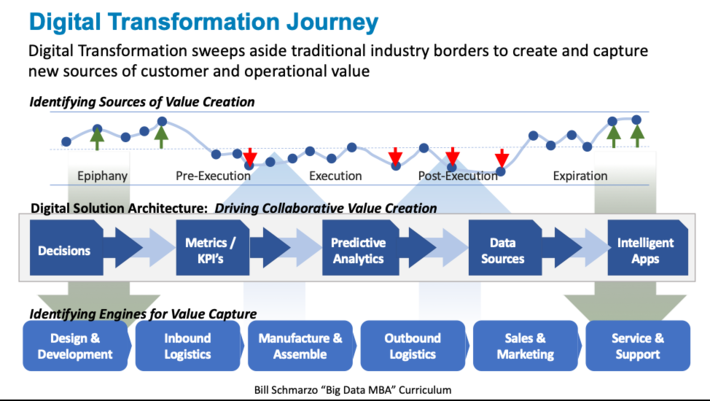
Figure 3: Digital Transformation Journey
See the following blogs for more details on Digital Transformation:
- “It’s Not Digital Transformation; It’s Digital “Business” Transforma…”
- “It’s Not Digital Transformation; It’s Digital “Business” Transforma…”
- “It’s Not Digital Transformation; It’s Digital “Business” Transforma…”
- “The Customer Journey Digital Transformation Workbook”
I will now introduce the “Digital Transformation Workbook” to identify, validate, value and prioritize the sources of customer and market value creation (use cases) and ascertain the digital assets necessary to capture these sources of customer and market value creation.
Digital Transformation Journey Workbook
The “Digital Transformation Journey Workbook” identifies the digital assets necessary to support an organization’s “smart” initiative. The Digital Transformation Journey Workbook is completed from the perspective of the key stakeholders that either impact or are impacted by the organization’s “smart” initiative (think Personas) and captures the digital assets (decisions, data, analytics, apps) necessary to enable the constituents to complete their “smart” journey and represent the sources of customer and market value creation.
Note: it probably seems strange that I’d designate “decisions” as digital assets, but decisions are the linkage point in monetizing the organization’s data, analytics and apps. Decisions by their nature are actionable, and when decisions are in support of an organization’s key business or operational initiatives, decisions can be a demonstrable source of value. Plus, a superior understanding of the decisions that your key constituents need to make provides a source of competitive advantage.
The Digital Transformation Workbook is comprised of two Design Canvases:
- The Smart Initiative Definition Canvascaptures the aggregated requirements for an organization’s smart initiative including the smart initiatives objectives, value proposition, potential impediments, and the KPI’s or metrics against which success will be measured. The Smart Initiative Definition Canvas also summarizes the aggregation of the supporting use cases and potential “intelligent” app requirements.
- The Customer Journey Design Canvasis created for each key stakeholder (think Personas) to ensure one has a holistic view of the “smart” spaces’ initiative requirements. The Customer Journey Design Canvas captures for each key stakeholder, their “journey” expectations, objectives, key decisions and metrics against which they will measure success across the 5 stages of their “journey”.
We will introduce the Digital Transformation Workbook via a “Smart” University initiative from the perspective of the student.
(1) Smart Initiative Definition Canvas
The Smart Initiative Definition Canvas defines the requirements for the “smart” places or things initiative. The Canvas captures the initiative’s business, operational, customer and society objectives, the potential impediments to successful implementation, the metrics and KPI’s that will be used to measure progress and success, the key stakeholders and constituents, the business entities around which we want to capture and monetize analytic insights, and top priority stakeholder use cases (see Figure 4).
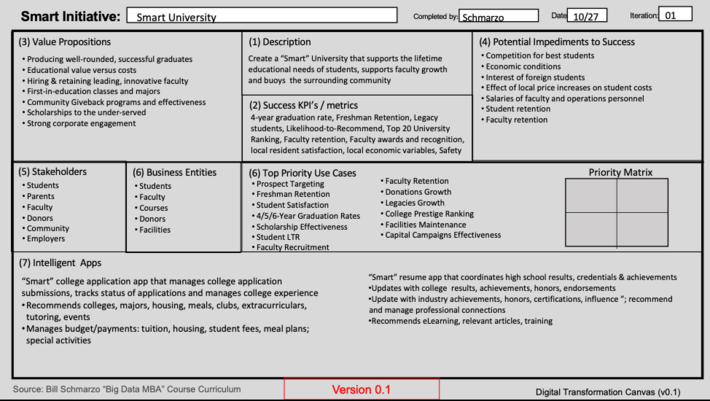
Figure 4: Smart University Design Canvas
The Smart Initiative Definition Canvas in Figure 4 also captures the operational requirements from the perspective of the key stakeholders in the form of “Intelligent Apps”. It is likely that the “smart” initiatives operational requirements and the desired analytics-infused outcomes that students and faculty need will manifest themselves into“Intelligent” apps that provide the predictions and recommendations that guides the stakeholders and constituents’ journeys.
(2) Stakeholder Journey Map Canvas
The Stakeholder Journey Map Canvas defines the holistic customer journey from the perspective of each of the key stakeholders. The Stakeholder Journey Map Canvas includes the objectives of the journey, defining what a successful journey looks like and listing the potential impediments to a successful journey. The Stakeholder Journey Map Canvas also analyzes and determines the stakeholder’s business and operational requirements from the perspective of the following 5 stages:
- Stage 1: Epiphany. This is the moment that the stakeholder is aware that they want to or need to complete a specific event.
- Stage 2: Pre-Execution. This is the prerequisites that need to be completed prior to executing the event.
- Stage 3: This is the actual execution of the event.
- Stage 4: Post-Execution. This is everything required to wrap up after the execution of the event including any assessments and evaluations, and a cost-benefit assessment.
- Stage 5: This is the afterglow (event evaluations, social sharing) that occurs some period after the completion of the event.
Then for each of the 5 stages, we will capture 1) a description of that stage, 2) they key decisions or outcomes the stakeholder requires of that stage, and 3) the metrics or KPI’s which will measure stakeholder progress and ultimately a successful journey. The Stakeholder Journey Map Canvas will summarize the stakeholder’s operational requirements in the form of an “intelligent app”. The “Intelligent” apps requirements include the predictions and recommendations that the stakeholder needs to support the successful completion of their journey (see Figure 5).
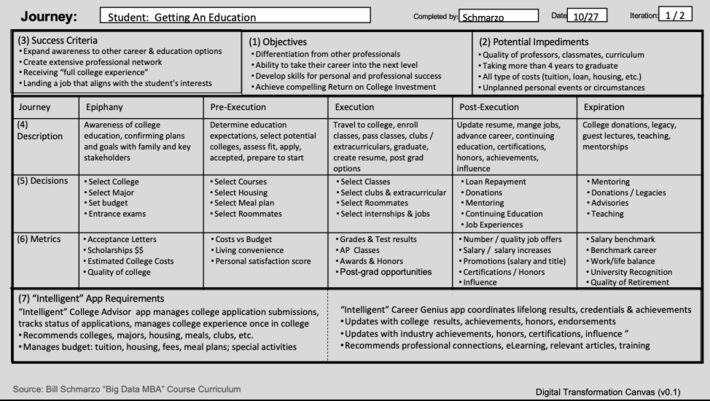
Figure 5: Student Journey Map Canvas
Creating “Intelligent” Apps
I’ve mentioned a couple times that the ultimate deliverable from the Stakeholder Journey Map Canvas are the intelligent apps that provide the recommendations that guides the stakeholder’s successful completion of their journey. Whether is supporting a family buying a home, or a person buying insurance, or a technician supporting plant operations, or an engineer building a car – the ultimate deliverable in these stakeholder journeys is to leverage data to provide analytics-infused recommendations that supports the successful completion of that journey.
Continuing our Smart University example from the perspective of the students, we identified two “intelligent” apps that would support the students’ more holistic, lifelong educational journey.
1) “Intelligent” College Advisor app (see Figure 6) which manages a student’s college application process and helps to manage college experience once in college including:
- Recommends potential colleges based upon the student’s interests and high school achievements, manages college application submissions, and tracks status of those applications
- Recommends majors/classes/lectures, housing options, meal plans, clubs, etc. based upon the student’s interests and college achievements
- Manages in-college budget including tuition payments, housing, fees, meal plans and special activities or events.
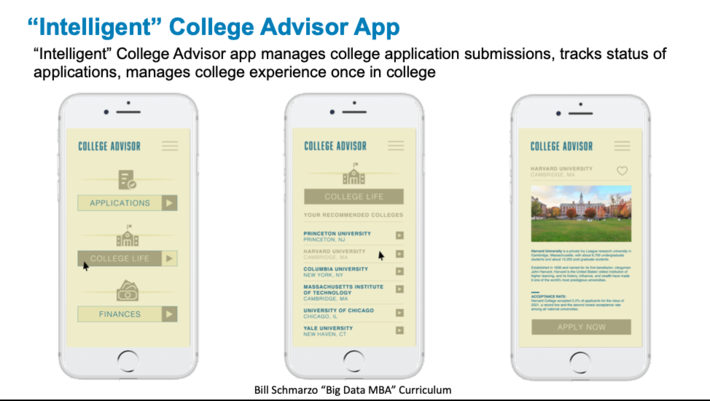 Figure 6: “Intelligent” College Advisor App
Figure 6: “Intelligent” College Advisor App
2) “Intelligent” Career Genius app coordinates one’s lifelong educational needs including:
- Updates with college results, honors, letters of recommendation and achievements
- Updates with job promotions, achievements, awards and honors (and no, achieving United 1K is NOT an achievement!)
- Updates with industry achievements, honors, certifications, achievements, endorsements, conference presentations and social influence
- Recommends professional connections, eLearning, relevant articles, training
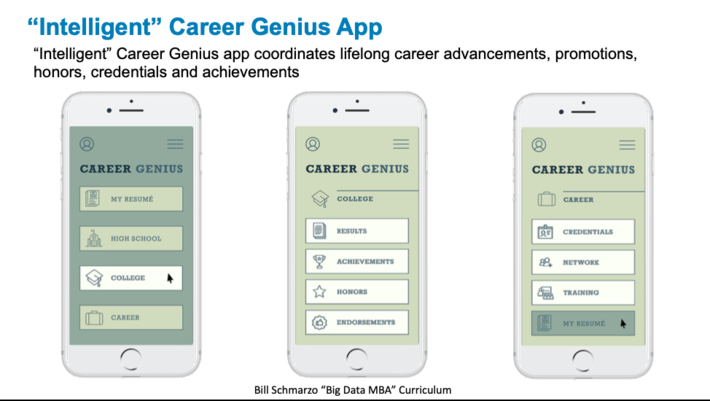
Figure 7: “Intelligent” Career Genius App
Digital Transformation Workbook Summary
I plan on the further exploration and validation of the Digital Transformation Journey Workbook while teaching and lecturing at the National University of Ireland – Galway next week. I want to incorporate the perspective of the faculty as well as the students when I test this methodology. And eventually, I hope to find a couple of customers with whom I can test this methodology to combine digital transformation and customer journey maps to create “smart” spaces (Michael? Doug? Kevin?)
My hope for this workbook is that it cannot only provide a more holistic view of the requirements for “smart” by looking at it from the perspectives of the stakeholders, but can also make the initiative more actionable or real with the articulation of the analytic needs to support the creation of “intelligent” apps that guide the stakeholders’ through their related journeys.
[1]“Putting points on the board” is a sporting analogy for sports such as basketball, soccer or football that seek to win their sporting events by outscoring their opponents earlier and more often; it’s hard to win these sporting events if you are relying on scoring all of your points at the end of the game.
